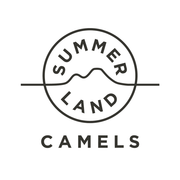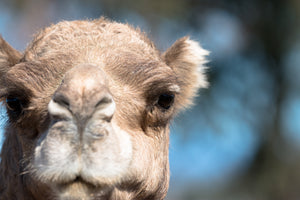Camel Myths Busted
Did You Know?
The Dromedary camel (also known as the Arabian one hump camel) was introduced into Australia in the 1840's to assist with exploration and transport. Their scientific name is Camelus dromedarius. Believe it or not, camels originated from Northern America. What other fascinating facts about camels are there?
1. The Hump is Made of Fat
The hump stores up to 35kg of fat which the camel can convert into water and energy. This enables them to travel great distances without food and water.
2. Can Drink 200L of Water
- Camels rarely sweat, so when they take in fluids they can conserve them for long periods.
- A thirsty camel can drink up to 200lt of water in 15 minutes.
3. Adaptations to Survive Harsh Conditions
- The Dromedary can close their nostrils to protect it from dust storms, has two rows of eyelashes and a third eyelid. This unique feature helps camels to protect their eyes from sand and the third eyelid acts like a 'windscreen wiper' to clean the eye.
- They have thick lips that enable them to eat prickly plants.
- You will see calluses on the camels' chest and knees. This protects the animal from hot sand or snow when it lies down.
- Big, thick and soft footpads for ease of walking on sand.
4. Reproduction
- The males have a large pink organ, which looks like a tongue that hangs off the side of their mouths called the dulla. This is to show their dominance and to attract the females.
- Females are sexually mature between the ages of 4-5 and males not until they are 6-7 years.
- The gestation period is between 13-14 months.
- The calf remains with its mother until it naturally weans.
5. Camel Milk Liquid Gold
- People have been milking camels for thousands of years as a source of nourishment.
- Camel milk has a very mild sweet/salty aftertaste and doesn't curdle.
- A camel will not produce milk unless she is calm, stress-free and with calf.
- Ongoing research suggests that camel milk has many medicinal benefits.
- Doesn't contain A1 beta-casein or betalactoglobulin and has lower levels of lactose than cow's milk, making it more tolerable for people who have dairy intolerance's.
- Is rich in vitamins, minerals and healing immune proteins and is an excellent source of nourishment for your microbiome.
- Dairy products made from camel milk such as gelato, persian-style feta, fromage blanc and haloumi are alternatives to cow, goat and sheep milk.
- Skincare made with camel milk has moisturising properties and can help treat and soothe skin conditions such as eczema, psoriasis and topical dermatitis.
6. Other Interesting Things
- Camels move both legs on one side of the body at the same time.
- Racing dromedary's can reach a speed up to 65km per hour.
- Wild camels are extinct, except for the roaming population in outback Australia.
- Males weigh 400 to 650kg and females are usually 10% smaller.
- Can carry up to 100kg for 60km in a day.
- A female camel is called a cow, male camel called a bull and baby camels a calf.

